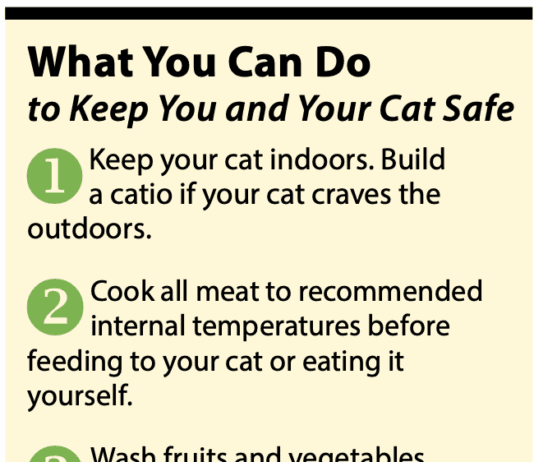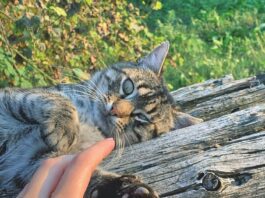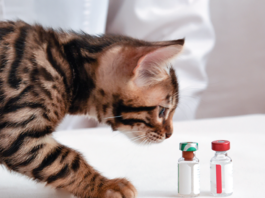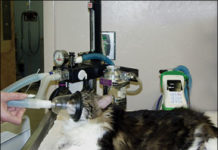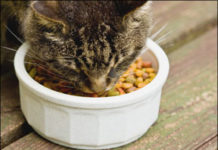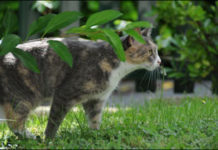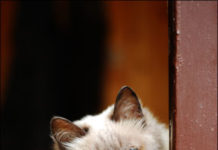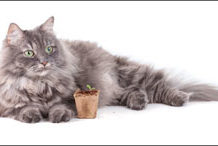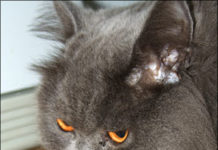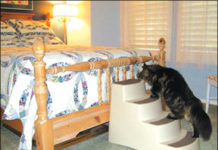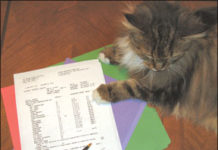Anesthesia: Whats Involved?
Any surgical procedure that will be painful to your cat - whether its a matter of stitching up a wound, pulling a tooth, repairing a fractured limb or removing a diseased organ - will require that the animals pain perception be dulled, if not totally blocked, by an anesthetic of some sort. What are the chances, an owner might wonder, that the animal, while surviving the operation itself, will fail to fully regain its senses? Or worse: What if it fails to awaken from its drug-induced sleep? "Theres always a risk," acknowledges James Flanders, DVM, an associate professor of surgery at Cornell Universitys College of Veterinary Medicine. "But if the cat is known to be in generally good health and if the anesthetic drugs are used properly, the chance that something will go wrong is very slim." Dr. Flanders assessment is supported by a study published in the Journal of the American Animal Hospital Association that involved tens of thousands of cats. Results showed that for every 1,000 deaths occurring during or subsequent to feline surgery, only one could be directly attributed to anesthesia. This impressive safety record is largely attributable to gains during the past half-century in understanding the medications that are used, and the techniques for monitoring the condition of the animal.
Short Takes: 10/09
House Resolution 3501 - more commonly referred to as the Humanity and Pets Partnered Through the Years, or HAPPY Act - would amend the Internal Revenue Code to allow an individual to deduct up to $3,500 for "qualified pet care expenses."These expenses are defined as "amounts paid in connection with providing care (including veterinary care) for a qualified pet other than any expense in connection with the acquisition of the qualified pet." "Qualified pet" is defined as "a legally owned, domesticated, live animal." It does not include animals used for research or owned or used in conjunction with a trade or business. Introduced on July 31, the measure was drafted in conjunction with data from the American Pet Products Associations National Pet Owners Survey. It has been referred to the House Committee on Ways and Means. The Pet Industry Joint Advisory Council (PIJAC) issued a Pet Alert on Aug. 5 supporting the proposal. "Providing pet owners the opportunity to deduct pet care expenses is an important step towards ensuring that pet owners provide adequate veterinary and other necessary pet care," PIJAC stated. "It encourages responsible pet ownership and will hopefully reduce the abandonment of pets by people struggling as a result of the economic downturn."
Feline Digestive Disorders
Digestive system disorders in general are among the most frequently observed health problems in cats. While many of these disorders are primarily associated with organs such as the liver, pancreas and gall bladder - all of which play a crucial role in the digestive process - plenty of them are centered in the alimentary canal, the long tube leading from a cats mouth to its anus. Most Common. By far the most prevalent feline digestive tract disorder, says Dr. Bartges, is inflammatory bowel disease (IBD). The condition, characteristically evidenced by chronic vomiting and diarrhea, is widely thought to be the consequence of several different disorders involving the feline immune system. The changes that are consistently found upon microscopic analysis in the lining (mucosa) of an affected cats intestines - a superabundance of immune system cells, for example - suggest that abnormal immune system activity may precipitate the disease.
The Long Arm of the Law
We live in a litigious society. We have laws governing birth, death and the taxes in between, so its no surprise that we also have a host of laws relating to the animals weve taken into our homes. At the federal level, laws generally address issues such as the safety of pet food, the impact of hazardous products on pets, evacuating and transporting pets during emergencies and regulating the use of animals in research. But most of the laws directly affecting our pets are made at the state and local level. These ordinances can differ by city, township and county, and pet owners should contact local officials when getting a new pet or moving to a new place to find out what possible laws pertain.
Recognize Senility in Your Aging Cat
Thanks to advances in veterinary medicine, its not uncommon for a cat to live to the ripe old age of 20 - roughly the physiologic equivalent of age 93 in a human. Thats the good news. The bad news is that cats, like humans, become increasingly susceptible to age-related disease conditions as they grow old, and most of these disorders are bound to have an effect on an animals behavior. For example, arthritis is likely to cause an active cat to slow down dramatically as it transitions through its golden years; kidney and urinary tract disease may affect its litter box behavior; progressive periodontal disease and tooth loss may alter its eating habits; and progressive hearing problems may make a cat decreasingly responsive to its environment. In some cases, however, an elderly cats behavioral peculiarities will remain unattributable to any underlying disease condition. In such a case, the animal is apt to be diagnosed as "senile," a vague term used to describe an animal that exhibits physiologically inexplicable cognitive dysfunction, the outward signs of which resemble those associated with age-related dementia and Alzheimers disease in humans.
Charges in Melamine Pet Food Recall
ChemNutra Inc., a Las Vegas-based ingredients broker, pleaded guilty on June 16 to federal charges of distributing tainted wheat gluten that led to the mass pet food recalls of 2007. The charges stem from a February 2008 indictment that alleged ChemNutra imported more than 800 metric tons of melamine-contaminated wheat gluten from China between November 2006, and February 2007, then sold the product to various pet food manufacturers.
Vomiting: When to Take it Seriously
You hear a familiar retching sound in the kitchen. Striker is vomiting up his dinner again. As you walk downstairs to clean up the mess, you wonder if its just hair balls - or something more serious that requires a trip to the veterinarians office. Cats vomit for numerous reasons, ranging from benign dietary indiscretion to potentially fatal systemic diseases such as renal failure or hyperthyroidism. The experts say that cat owners should pay close attention to a cat that regularly becomes sick to his or her stomach. Be Observant. "When it comes to vomiting, the important concept for cat owners is observation," advises Fred Scott, DVM, PhD, interim director of Cornells Feline Health Center. "Vomiting in association with signs of systemic illness must be addressed rapidly." Signs include lethargy, fever, loss of appetite or weight loss. Even if the cause of vomiting is transient or self-limiting, loss of fluids and electrolytes can have life-threatening consequences.
Diagnosis: Bladder Stones
Your cat normally uses the litter box a few times a day to relieve herself, but today is different. Shes going to the box every few minutes and vocalizing as she strains to urinate. The small amount of urine that finally dribbles out is filled with blood. Your cat may be suffering from bladder stones, a painful condition that, left untreated, can lead to serious illness and in rare cases, death. Causes of Bladder Stones. Bladder stones, or uroliths, are caused by an extensive concentration of salts and minerals in the urine such as magnesium, phosphorous, calcium, and ammonia. "There should always be a certain amount of salts and minerals in the urine," says Richard Goldstein, DVM, an associate professor of small animal medicine at Cornell Universitys College of Veterinary Medicine. "But when the urine becomes super saturated - meaning theres an overabundance of salts and minerals - crystals begin to form."
Protect Your Plants and Keep Kitty Happy: Grow Grass Indoors
Everyone knows that cats are carnivores. So why does your cat keep snacking on the houseplants? Some experts say greens help cats get rid of hairballs, others that cats crave the fiber and moisture. There may be a nutritional component as well: when feeding on prey, a cat will eat the intestines first, where its likely to find plant matter. But regardless of the reason for the craving, plants can prove a serious danger to cats. Many common houseplants, such as lilies, asparagus ferns, and foxglove, are poisonous. Outdoors, a cat may eat grass or other plants contaminated by pesticides and fertilizer.
Ask Elizabeth: 06/09
The dark brown color of normal cat stool largely results from substances in the bile, a liquid produced in the liver that then empties into the first part of the small intestine. Bile aids in the digestion of fats and contains a number of substances, among which are breakdown products of aged red blood cells. These breakdown products impart the yellow color that is characteristic of bile. As these yellow pigments pass in stool on the way out of the body, bacteria residing in the large intestine break them down further, so their original yellow color is changed to a dark brown.
Is Your Cat Slowing Down?
At the age of 12, your cat seems to be slowing down a bit, and that could be perfectly normal. After all, a cat of her age - equivalent to the age of 65 or so in a human - has been living a full life and deserves to take it easy on herself. Nevertheless, its a good idea to have the animal checked out by your veterinarian. Its quite possible that her diminished activity is a consequence not of her advancing age but of a debilitating pain in one or more of her joints. Slowed-down, reclusive behavior is an indication of a joint problem in cats of any age, says Christine Bellezza, DVM, a consultant at the Cornell University's College of Veterinary Medicines Feline Health Center. "Some of the signs are very subtle," she points out. "An affected cat may seem lethargic and may increasingly seek out comforting places to nap - in a warm corner of your home, for example, or in a spot of sunshine near a window." The reclusive behavior can also be attributed to a deeply ingrained feline instinct for self-protection. A cat may want to conceal its disability for fear of alerting a potential predator to its vulnerability. Other indications that a cat is suffering pain in one or more of its joints may not be so subtle. "The cat may have trouble hopping in and out of its litter box," says Dr. Bellezza, "and it may avoid going up and down stairs." It is also possible for a cat with a severe joint problem to become constipated because it cant position itself properly to defecate. Furthermore, due to joint pain, an affected cat may be unable to groom itself thoroughly.
Feline Pancreatitis: Serious
Although the feline pancreas is a relatively small internal organ, typically weighing no more than six or eight ounces, it plays a demanding and multifaceted role in maintaining a cats robust health. Indeed, a disease or injury that results in the inflammation of this vital organ - a condition called pancreatitis - could prove fatal unless the animal receives prompt, and potentially quite expensive, medical care. The pancreas is a slender, pink, v-shaped strip of tissue resting snugly within the cats abdomen between its left kidney and its duodenum. It is a glandular organ that performs two life-sustaining functions-endocrine and exocrine. While still in the pancreas, explains Richard Goldstein, DVM, an associate professor of small animal medicine at Cornell Universitys College of Veterinary Medicine, these digestive enzymes are normally sequestered in tiny droplets that prevent their coming into direct contact with pancreatic tissue. Moreover, he says, the enzymes are biologically programmed to remain inactive until after they have been secreted and have traveled via the pancreatic duct into the small intestine.

